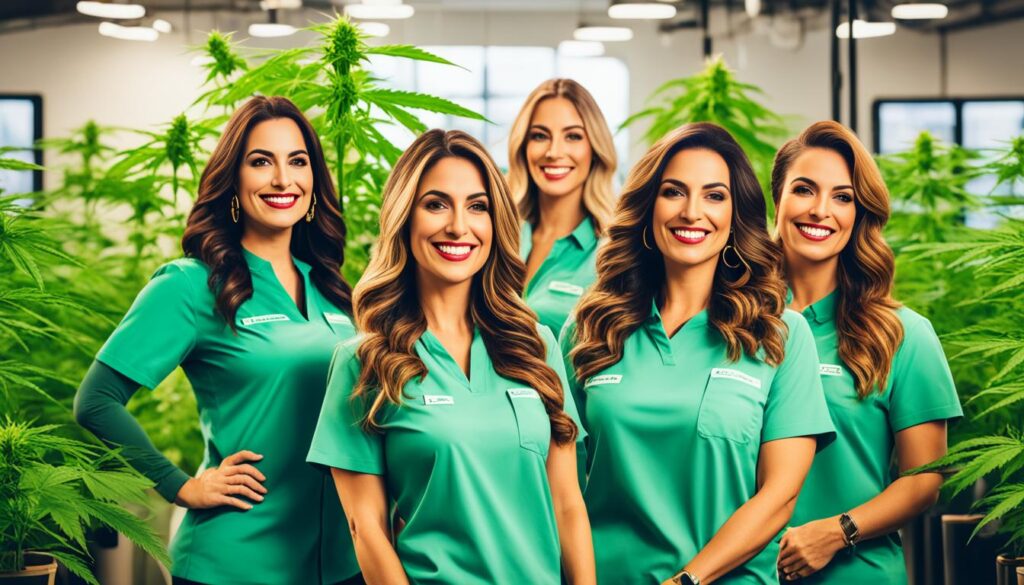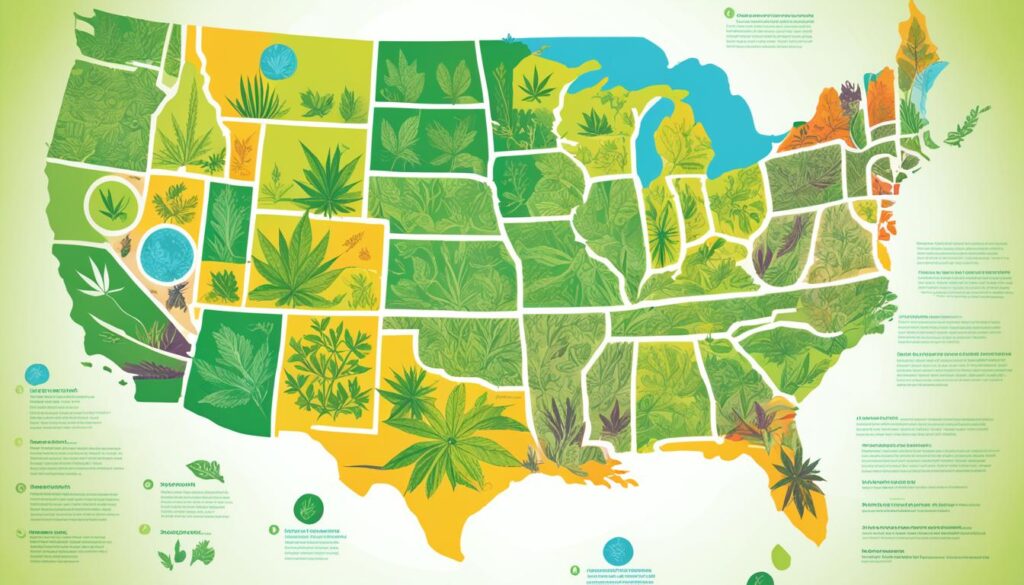Weed, marijuana, and cannabis have always been a big part of Latina culture. But, they’ve also been seen as taboo. This guide will cover the history, the cultural shift, and why seeing more Latinas in the cannabis industry is key.
We’ll look at the legal side, the good things about weed for Latinas, and how they’re making their mark. They’re breaking down walls and welcoming weed into their lives.
Key Takeaways
- Weed has been a part of Latina culture, but it has also faced significant stigma.
- The cannabis industry is rapidly evolving, providing opportunities for growth and entrepreneurship for Latinas.
- Latinas are reclaiming cannabis as medicine and wellness for their culture, and more are entering the cannabis industry.
- Representation and breaking down barriers are crucial for Latinas in the cannabis industry.
- The legal landscape and the benefits of weed in Latina are important considerations.
The Historical Stigma of Weed in Latina Culture
Mexican immigrants brought marijuana to America after the Mexican Revolution of 1910. This made people fear and dislike Mexicans more. Anti-drug campaigns in the 1930s made things worse, linking marijuana to violence and crime.
Mexican Immigrants and Recreational Marijuana Usage
Mexican immigrants brought their love for marijuana to the U.S. But Americans didn’t like it. They saw it as a sign of something wrong with the Spanish-speaking people. This made a big problem for the Latina community.
Negative Connotations and Anti-Drug Campaigns
In the 1930s, people and the media said bad things about marijuana. They linked it to violence and crime. This made the problem worse for Mexican immigrants.
“In a New York Times headline from 1925, a man crazed by marihuana attacks with a butcher knife, indicating a change in the drug’s perception.”
The stigma against marijuana and its link to Mexican immigrants has hurt the Latina community. We need to understand this issue better. It affects how people see the drug and its users.
Reclaiming Weed in Latina: A Cultural Renaissance
The Latina community is slowly letting go of the weed stigma. A 2014 Pew Research survey found 81% of U.S.-Hispanics support some form of legalization. Now, Latinas are breaking barriers in the cannabis industry.
Changing Attitudes and Legalization Efforts
Susie Placencia, a Mexican American cannabis activist, is working to end the stigma. She founded Humo, Mota Glass, and Latinas in Cannabis. As more states make marijuana legal, the Latina community is embracing weed again.
The Rise of Latinas in the Cannabis Industry
Latinas are fighting the negative views and becoming leaders in cannabis. Entrepreneurs like Placencia are making space for other Latinas. They work in growing, making products, selling, and teaching. Latinas are changing the cannabis world to be more open and fair.
“We’re not just consumers, we’re also entrepreneurs, experts, and advocates. Latinas are reclaiming our place in the cannabis industry and redefining what it means to be a Latina in this space.”- Susie Placencia, Founder of Humo, Mota Glass, and Latinas in Cannabis
Weed in Latina: Breaking Down Barriers
The Latina community has faced big challenges in the growing cannabis industry. Only 5.7% of the businesses are owned by Latinas. This shows how deep the stigma and negative views are in the community.
Latinas are working hard to overcome these barriers. They want to make more chances for themselves and others. Lilach Vilchis became the first female president of a cannabis company in Nevada in 2014. She faced big challenges, like not being able to use banks because the industry is not fully legal.
Vilchis’ story shows the tough road Latina entrepreneurs face. They have to meet strict rules and find enough money to start. But, women like Vilchis are pushing forward. They want to make their mark in this changing field.
The Latin American cannabis market is set to grow a lot in the future. This means big chances for Latina entrepreneurs. But, the industry needs to work on being more diverse and fair. This will help the Latina community shine in the cannabis industry.
“The lack of federal legality for the marijuana industry presents significant challenges for Latina entrepreneurs like myself. We must overcome these hurdles to achieve the success we deserve.”
As the cannabis industry grows, it’s key that Latinas get the support they need. By breaking down barriers, Latina leaders can motivate a new wave of Latina entrepreneurs in the cannabis industry.
Embracing Weed in Latina: From Stigma to Success
Many Latinas face pushback from their families when they choose to work in the cannabis industry. The stigma around marijuana in the Latino community is strong. But, a group of Latinas are fighting back, showing that they belong in this industry.
Overcoming Family Pushback
For a long time, marijuana has had a bad name in Latino culture. Latinas who want to work in cannabis must first win over their families. Latina stigma and family pushback are big challenges. But, people like Carolina Vazquez-Mitchell of Ciencia Labs are showing the way.
Latinas as Professionals in the Cannabis Industry
Despite the challenges, more Latinas in cannabis are becoming leaders. They’re breaking down stereotypes and opening doors for others. These women are showing that they can do well in this field. They’re encouraging other Latinas to see the cannabis industry as a good career choice.

“The cannabis industry needs more Latinas. We have so much to offer, and we can bring a unique perspective that is essential for the growth and success of this industry.”
– Carolina Vazquez-Mitchell, Founder of Ciencia Labs
The Importance of Representation in weed in Latina
For the Latina community, having a place in the cannabis industry is key. Only 5.7% of these businesses are owned by Latinas. It’s important for more Latinas to step up and show their strength, even with the challenges they face. This will help make weed more normal in Latina culture and give young Latinas role models.
Latinas are breaking into the cannabis world, changing the old boys’ club. Rollin Rosa, by Vanessa Cardenas and VCR, offers luxury pre-rolls in over forty stores in the Midwest. Tranquil Highs, by Amorinda Martinez, brings medicinal experiences to the West Loop, using her twenty years in healthcare.
LizMarie Palomo, who began as a budtender, now runs her own brand, Mota Mami. She’s inspiring other Latina entrepreneurs. Groups like SuperNova Women and Latinas in Cannabis support and empower Latinas in the field.
The cannabis market is booming, with over $400 million in taxes in Illinois last year and over a billion in sales. But, high prices in stores make some turn to illegal sellers. It’s important to fix this and make sure everyone has fair access.
As the cannabis industry grows, the role of representation for Latinas is vital. By overcoming obstacles, fighting stereotypes, and showing Latina leadership, we can change the story. This will lead to a more open and successful future in weed for the Latina community.
“In the legal cannabis industry, it is highlighted that including Black and Brown women is crucial to address racial disparities.”
Navigating the Legal Landscape of weed in Latina
The Latina community is learning about the changing laws on cannabis. It’s important to keep up with new laws and rules. Weed laws are different in each state and country. Some places let people use it for health or fun, while others say no.
In the U.S., weed laws are not the same everywhere. 33 states and D.C. say it’s okay for medical use. 11 states and D.C. let people use it for fun. The Latina community needs to know the laws in their area to stay safe.
Outside the U.S., weed laws are changing too. Some places like Uruguay and Mexico are making it easier to get. But, other places are still strict. It’s hard for the Latina community to keep up with these changes.
| Statistic | Value |
|---|---|
| Cannabis use in the U.S. | 24.0 million people age 12 or older (8.9% of the population) |
| Cannabis use among 18-25 year olds | 20.8% prevalence rate |
| Tobacco users in the U.S. | 63.4 million (23.5% of the population) |
| Alcohol users in the U.S. | 136.7 million (50.7% of the population) |
| Estimated global legal cannabis market by 2030 | $75 billion in sales |
The Latina community needs to keep up with the law. They should get advice from lawyers and work for fair laws in the weed industry. By understanding the law and talking about it, they can make a future where weed is okay and safe.

Health and Wellness: Exploring the Benefits of weed in Latina
Weed in Latina culture is getting more popular. People see its health and wellness benefits. It helps with pain and stress.
Studies show weed can help with chronic pain, cancer, and more. In Colorado, most people use it for pain. Many use it to feel better.
It’s not just for the body. Weed helps with feelings too. After COVID-19, more people used it to relax.
| Benefit | Findings |
|---|---|
| Pain Management | Medical cannabis use in pain patients was associated with a 64% reduction in opioid use. Prescription data from Medicare Part D enrollees in states with medical cannabis access showed a significant reduction in conventional pain medication prescriptions. |
| Nausea and Vomiting | In adults with chemotherapy-induced nausea and vomiting, oral cannabinoids are effective antiemetics. |
| Multiple Sclerosis (MS)-related Spasticity | In adults with multiple sclerosis (MS)-related spasticity, short-term use of oral cannabinoids improves patient-reported spasticity symptoms. |
Latinas are starting to see weed’s health benefits. This could lead to more people using it for wellness.
“Cannabis is the third most commonly used drug in the United States after alcohol and nicotine, and almost one in four cannabis users met diagnostic criteria for Cannabis Use Disorder (CUD) among college students.”
Weed’s use in Latina culture is changing. People see it as a way to improve health. As research grows, so does its acceptance.
Conclusion
The story of weed in Latina culture is complex and interesting. It has changed a lot over time. The community has faced many challenges but is now making progress.
Latinas are now breaking barriers and speaking up. They are making a big impact in the weed industry. This change is making the future of weed in Latina look very promising.
Stars like Anitta, Alemán, Ozuna, Soulfía, Akapellah, Marcelo D2, Lokillo, and La are leading this change. They use their voices and creativity to make weed more accepted. They’re helping to make a future where weed is celebrated.
The future of weed in Latina is full of chances for growth. By learning more, talking openly, and supporting Latina businesses, you can help. Together, we can shape the future of weed in Latina. The possibilities are endless.


I have used Apha KushOG (alphakushog@gmail.com) at least 3-4 times and every time it has been top notch. He is the best local plug you can find around. He is very pleasant, friendly and fast. He is a lifesaver.
He sells top shelf WEED and other stuffs at moderate prices. I will always recommend this guy when people ask me my ” go-to”. All you have to do is follow his instructions.
Just send him an email and I bet you will come back for more once you finish what you bought because the quality is incredible.
Contact him on his telegram link telegram : t.me/alphakushOG
⚠️ Know that he do not have telegram channels only the telegram link above
He sells the best hash and high quality weed you can ever find here in Latina.
I highly recommend his services too.
Alpha is the way to go.
Alpha Ogkush (alphakushog@gmail.com) is the top service so far. Great service, easy to work with and I’m very satisfied. I’m so happy I found Alpha . He is super responsive, on time and the quality of weed he sells are serious on point and top notch.

I followed his instructions and sincerely I was skeptical at first but he finally showed up on time. I will definitely be ordering from him more often because he is the only reliable local plug you can trust so far.